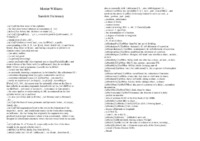| dc.contributor.author | Sir Monier Monier-Williams, Professor E. Leuman, Professor C. Cappeller and other scholars | |
| dc.date.accessioned | 2016-02-19T15:37:46Z | |
| dc.date.available | 2016-02-19T15:37:46Z | |
| dc.date.issued | 1920 | |
| dc.identifier.isbn | 9780198643081,019864308X | |
| dc.identifier.issn | | |
| dc.identifier.uri | http://ir.nmu.org.ua/handle/GenofondUA/6598 | |
| dc.description.abstract | The first problem people seem to be having with this famous dictionary is that some of the more recent reprints of the original Clarendon Press edition (especially the Indian ones) are physically of very poor quality: not only are they poorly printed on inferior paper, but they also come with a shoddy binding that is just not going to stand up to the sort of handling a heavy dictionary gets. Books such as this (and there are many being published today) seem to me almost to have been deliberately designed to self-destruct after minimal use.
The only solution to this problem is not to buy a later reprint in the first place. Instead, look for a used copy of the earlier UK-produced Clarendon Press edition. This was well-printed on quality paper, stitched so that it opens flat without the spine cracking, and bound in a durable cloth. If you are lucky enough to find one of these you will be getting a real book that will be a pleasure to handle and will stand up to many years of heavy use.
The second problem that some people run into is that the dictionary itself can, because of its arrangement, be difficult to use. An excellent solution to this problem has been provided by Charles Wikner in his 'A Practical Sanskrit Introductory' (1996).
This is a superb and extremely useful 146-page Sanskrit tutorial in 15 lessons which, besides teaching Sanskrit pronunciation, Devanagari, and some basic principles, has also been designed, as Wikner says, "to lift the English-speaking student who knows nothing of Sanskrit to the level where he can intelligently [use] Monier-Williams' dictionary."
He explains that Lessons 12-14 "penetrate Monier-Williams' dictionary through its four levels of alphabetical order, and suggest strategies for finding difficult words." After studying these three lessons, users should have no further difficulty with the dictionary; in fact, it will become a real pleasure to use.
The author has generously made his book freely available and it can be downloaded from: http://sanskritdocuments.org/learning_tutorial_wikner/index.html | |
| dc.language.iso | English | |
| dc.publisher | Oxford University Press, USA | |
| dc.subject | Языкознание\\Словари | |
| dc.subject | Linguistics\\Dictionaries | |
| dc.subject.ddc | | |
| dc.subject.lcc | | |
| dc.title | A Sanskrit-English Dictionary | |
| dc.type | other | |
| dc.identifier.aich | TERR5OR3564HKHQ7DFZ7Z4X4QRZSRROK | |
| dc.identifier.crc32 | B8EF533B | |
| dc.identifier.doi | | |
| dc.identifier.edonkey | 14BADCB973C4D39A9146E5A5269D4101 | |
| dc.identifier.googlebookid | | |
| dc.identifier.openlibraryid | OL20170346M | |
| dc.identifier.udk | | |
| dc.identifier.bbk | | |
| dc.identifier.libgenid | 311444 | |
| dc.identifier.md5 | 3EB9880D63682AFD56BE7B2A65B45EF8 | |
| dc.identifier.sha1 | 6HGU2YTMVL6BKZKGD42XEDUTLOTSNEDE | |
| dc.identifier.tth | F5EMSUN2AS73TGIYLJ5JQQIL2QGOBF25AFEOPHI | |

